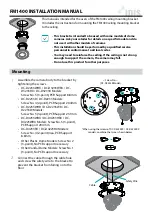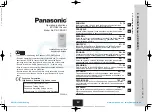
BODYGUARD-T
Installation Instructions
I-EA00206
Rev 01, Rev Date: 05/08/2018
Page
4
of
12
Hager Companies 139 Victor Street, St. Louis, MO 63104 (800) 325-9995 www.hagerco.com
5. ELECTRICAL INSTALLATION
INSTALLATION & CABLING
1.
Once the Bodyguard-T is securely attached to header, cabling and wiring may be completed.
a.
For monitored door controls, use the cable provided for use with the 10-pin connector.
DO NOT USE
the 7-pin terminal – this is not designed to be used with monitored systems.
The 10-pin connector is to be used
for monitored door controls and can also be used for non-monitored door controls.
See diagram and table below for 10-pin
connection. Also verify that the monitoring DIP switch is set to ON (see page 7).
b.
For non-monitored door controls, use either the cable provided for use with the 10-pin connector (leaving the two MONITORING
wires unterminated at the control)
OR
use the 7-pin terminal. See diagram below. The monitoring DIP switch must be turned
OFF to function while in a non-monitored status (see page 7).
If wiring the Bodyguard-T to a Hager module such as an LO21 or an MC15, refer to the schematic for the respective module.
2. Once wired, feed the opposite end of the cable through the previously drilled wire passage hole (MECHANICAL INSTALLATION, step 3),
and into the header. Pull the cable completely through and route it to the location of the automatic door control. Refer to the respective
User’s Guide for the Hager product with which you are interfacing. Ensure a dedicated power source of 12 or 24 VAC / VDC ± 10% (1024VAC
may be used for powering this product).
10-PIN CONNECTOR
Position
Connection
Wire Color
1
12 – 24 VAC/VDC ±10%
Black
2
12 – 24 VAC/VDC ±10%
Red
3
Common
White
4
Normally Open
Green
5
[empty]
[empty]
6
Normally Closed
Yellow
7
Monitoring (+)
Yellow
8
Monitoring (-)
Purple
9
Data (+)
Blue
10
Data (-)
Brown
If monitoring is not being utilized, 12 – 30 VDC must be applied to 7 and 8.
Observe polarity.






























